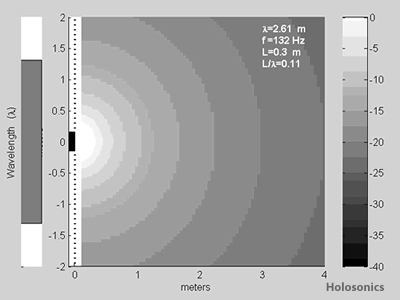directivity demonstrations
The simulations on this page serve to demonstrate the following:
The directivity of all traditional loudspeaker devices is fundamentally limited by nothing more than the size of the source compared to the wavelengths it generates.
No amount of phasing, shading, focusing, or any other method can overcome this fundamental limit; in fact, any of these methods will always reduce directivity.
It is impossible for any loudspeaker to approach the directivity of the Audio Spotlight.
For more detailed information about these demonstrations, and loudspeaker directivity, visit our main article: Fundamental Limitations of Loudspeaker Directivity.
FIXED SOURCE SIZE, VARYING WAVELENGTH
The first set of simulations is of a fixed source size (0.4m/16"), with varying wavelength. From the statements above, we expect to see an omnidirectional response for a large wavelength relative to source, and higher directivity as wavelength decreases.
Figure 1
FIGURE 1
Ideal sound fields from a 16"/0.4m source, with varying wavelength. Directivity is weak for wavelengths similar to source size, but increases for very small wavelengths (high frequencies).
This is precisely what is observed; for wavelengths much larger than the source, the sound field is omnidirectional. Modest directivity is shown for wavelengths similar to the source size, and as the wavelength decreases to a small fraction of the source size, the loudspeaker is always naturally directional.
Figure 2
FIGURE 2
The wavelength is fixed at 0.4m (1kHz) while the source size is varied. A source smaller than or comparable to the wavelength is mostly omnidirectional, while a large source becomes more directive.
For a small source ¼ of the wavelength, the sound field is again omnidirectional. As the source size increases, directivity increases as expected. But notable directivity exists only when the size source is much larger than the wavelength.
Phasing and Focusing
Phased arrays have been used for decades to steer and/or focus acoustic energy, as well as other wave sources (such as radar). The basic principle is to apply a suitable delay (or phase offset) to each small portion of the source, such that the contributions from each element of the array sum constructively along the desired direction (for a steered array), or at a particular point (for a focused array). As isolation is typically the goal of directivity (and steering decreases directivity), the focused case will be simulated. Phasing a linear array is acoustically equivalent to building a perfectly curved loudspeaker array, or using a perfect reflecting surface.
For this simulation, we will allow a very large loudspeaker size of 1m (39"), and a 1kHz tone. Distance is analyzed continuously from 0.5m to 2.5m. A small circle marks the focal point.
Figure 3
FIGURE 3
Sound fields from a 1m source playing 1kHz, perfectly focused to distances ranging from 0.5m to 2.5m. Focus is apparent at short distances, but has no clear effect at distances longer than about 0.5m.
A reasonable degree of focus is noted for the 0.5m case, but the sound fields for focal lengths beyond this are nearly identical to the unfocused case. This makes sense qualitatively; one cannot expect to focus effectively at distances much further than the size of the source array.
Note also that while focusing is effective for very short distances, the cost is directivity – outside the focal point, sound expands far more than it would have with an unfocused array. Therefore, as a practical matter, focusing arrays are not effective for providing localized listening zones.
CONCLUSIONS
Loudspeaker sources of a variety of configurations are used to illustrate that even under ideal circumstances, directivity and localization of sound is extremely limited. No degree of phasing, focusing, or other manipulation can improve these results, as they are an inherent limitation of traditional acoustics.
The Holosonic® technique for sound generation in the Audio Spotlight is a fundamentally different way of creating sound, and is not limited by the barriers facing traditional acoustics illustrated above. This is because the source of sound from an Audio Spotlight is not the physical loudspeaker panel – it is the volume of air in front of it. This makes the actual sound source far larger than the physical loudspeaker seen – it just happens to be invisible, and made from ultrasound. This enables the Audio Spotlight to fundamentally provide far more directivity and isolation than any loudspeaker can ever provide.
For more information, please visit our main article: Fundamental Limitations of Loudspeaker Directivity.




